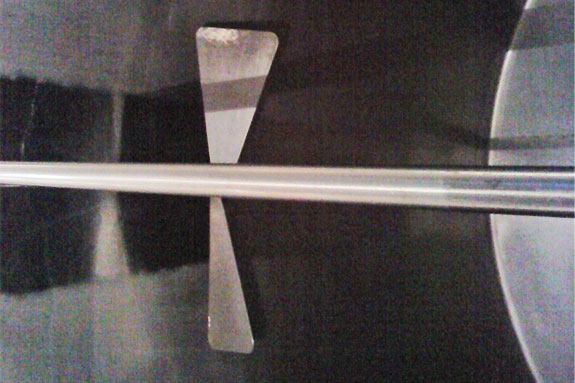Last year, we wrote about a producer from North Dakota who was constantly changing his inflations (see “Time to change the inflations … again,” Progressive Dairyman, September 22, 2010, pg. 85). You may recall … we associated the old Dunkin’ Donuts commercial “Time to make the doughnuts” with this producer’s tedious task of changing inflations. Here’s an update on that “inflation devastation”: The results are a slam-dunk where time, money and milk quality are concerned.
During our first visit, the producer showed us the damaged inflations. Plus, his rubber gaskets, O-rings and hoses were drying, cracking and inking. We also documented premature cracking, discoloration and damaged interior surfaces to various plastic parts, including claws, meters, elbows, tees, milk hoses and milk wash plugs.
While all these parts play a crucial role in maintaining milk quality, damage to an inflation can be most costly. As an inflation wears out, somatic cell counts typically rise as teat ends are damaged and cows milk out slower.
What was causing the damage to the equipment? This producer was milking 300 cows three times a day and did not have enough time to properly wash between milkings. Sadly, his milking team skipped a few washes and tried to make up for it by “shocking” the system and exceeding alkaline and chlorine recommendations.
This treatment unnecessarily increased chemical use and costs, damaged rubber goods, broke down plastic parts and just plain wasted money. The producer also experienced varying bacteria counts, jeopardizing milk quality and premium payments.
If you’ve been following this CIP column, you know that we discourage shocking a system because it shortens equipment life, increases groundwater contamination, endangers safety and wastes money. Plus, it doesn’t correct the source of the problem.
At this operation, the producer’s CIP system took too long for the number of cows he was running through the parlor. He couldn’t consistently milk all his cows – plus effectively clean up. Together, we determined that a single-cycle CIP detergent, free of alkaline and chlorine, would be a good fit for his dairy.
Slam-dunk results
“More time. Less cost. And more cows,” is how the producer summed up the results of switching to a single-cycle cleaner. “It’s been about 18 months since we switched.
We’re still milking about 23 hours a day, but we’re now on a regular routine. With standard washing procedures, we didn’t have enough time to clean. Now, with one less cycle, we have more time to do the job right.”
Less cost: the single-cycle cleaner reduced chemical costs at this dairy by 25 percent, decreased the amount of water used for cleaning and reduced energy consumption.
Another huge benefit is they can run 50 more cows per shift through the parlor because of the extra time they are saving with one wash cycle. They now milk more than 400 cows, up almost 150 cows from 18 months ago.
“Things are getting done on time,” says the North Dakota producer. “We stay on schedule and the cows like that – they are creatures of habit and the consistency pays off with more milk. We’re up about five pounds per cow per day.
“Our employees don’t like the shorter cleaning cycle as much, though. They used to have a longer break during the wash cycle,” he adds with a smile.
Less hassle, fewer chemicals
The single-cycle cleaner is more convenient and safer for employees due to reduced chorine and chemical use. This herd owner also is using less water that eventually ends up in his lagoon. In just cleaning the parlor alone, he figures he saves 150 gallons of water per day. Add it up … that’s 54,750 gallons of water saved per year.
Due to the success of the pipeline cleaning, this producer is now also using the single-cycle cleaner on his bulk tank. “We always had such a small window of opportunity between getting the milk picked up and cleaning the tank,” adds the producer. “This change to our total CIP system makes things so much easier.”
Adding to the “less hassle” list: This farm has two less drums of product to deal with – one drum of the single-cycle detergent versus three is easier for the employees and better for the environment.
“Less product is good for everyone. We literally cut our soap volume in half. We formerly used about 50 to 55 ounces of soap; now we’re down to about 28 to 30 ounces. In addition, we eliminated chlorine and acid costs – and their containers. Again, it’s easier and safer for our employees and the environment.”
Time to change the inflations?
This producer originally called us because of the constant damage he was seeing to his inflations. He now is changing inflations on a normal, recommended rotation, based on his herd size.
“They don’t break down as quickly because we’re not using chlorine-based chemicals,” he states. “And there is less damage to our plastic parts. We’ve definitely seen more longevity.”

One more tedious and costly chore off this producer’s task list. So, after my follow-up visit, I asked the producer if he had time for coffee and doughnuts. We both laughed and headed into town. PD
PHOTO A
The inside of the bulk tank when it was being cleaned with standard washing procedures (note the build-up).
PHOTO B
The results of the single-cycle cleaner.

This producer used less water, energy, time and chemicals and now has a cleaner bulk tank, plus lower bacteria counts and higher premiums. Photos courtesy of Ron Robinson.
Want to know how well your CIP system is doing? Submit a photo of your CIP challenges or a question to Progressive Dairyman . In future issues, A&L Laboratories experts will comment on the photos or questions.
Dairy names and locations will not be connected with photos, so your review will be completely anonymous. Send your photos and questions to walt@progressivedairy.com

-
Ron Robinson
- VP Business Development
- A&L Laboratories
- Email Ron Robinson





